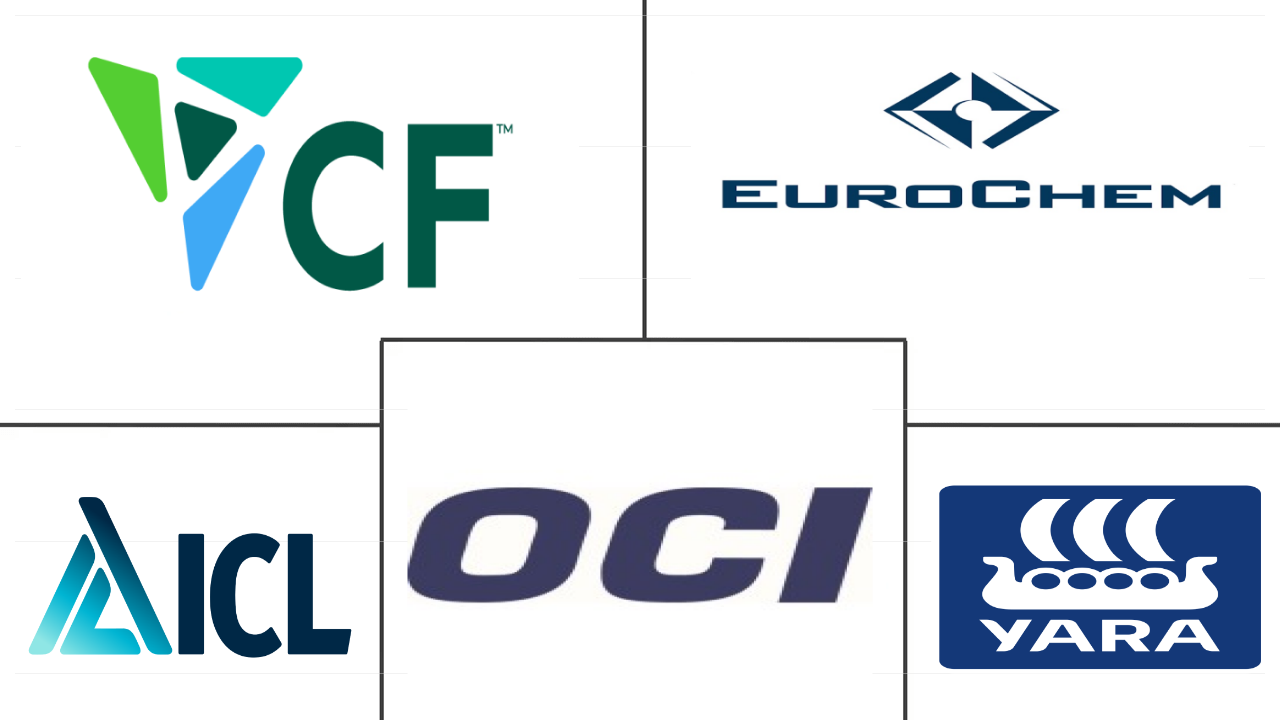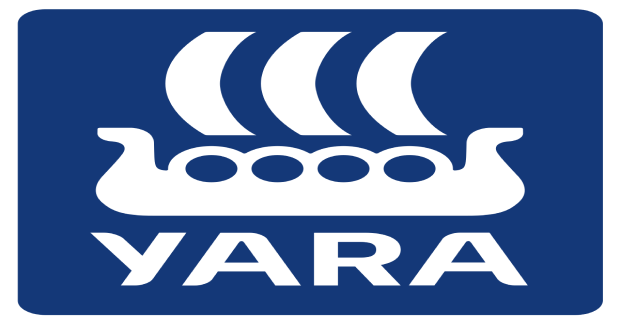Market Size of europe fertilizers Industry
|
|
Study Period | 2017 - 2030 |
|
|
Market Size (2024) | USD 52.67 Billion |
|
|
Market Size (2030) | USD 72.27 Billion |
|
|
Largest Share by Crop Type | Field Crops |
|
|
CAGR (2024 - 2030) | 5.41 % |
|
|
Largest Share by Country | Russia |
Major Players |
||

|
||
|
*Disclaimer: Major Players sorted in no particular order |
Europe Fertilizers Market Analysis
The Europe Fertilizers Market size is estimated at 52.67 billion USD in 2024, and is expected to reach 72.27 billion USD by 2030, growing at a CAGR of 5.41% during the forecast period (2024-2030).
52.67 Billion
Market Size in 2024 (USD)
72.27 Billion
Market Size in 2030 (USD)
5.40 %
CAGR (2017-2023)
5.41 %
CAGR (2024-2030)
Largest segment by Product
23.90 %
value share, Ammonium Nitrate, 2023
Ammonium nitrate emerged as the dominant nitrogenous fertilizer in the European market. They boast greater stability, preventing nitrogen loss through volatilization.
Largest Segment by Crop Type
84.07 %
value share, Field Crops, 2023
The high consumption of fertilizers in the field crop segment is driven by the depletion of soil nutrients resulting from intensive farming and monocropping of field crops.
Fastest Growing Speciality Type
7.76 %
Projected CAGR, CRF, 2024-2030
CRFs provides a gradual and sustained release of nutrients overs an extended period, offering improved efficiency which is contributing to it's market growth.
Largest segment by Country
20.94 %
value share, Russia, 2023
Russia is one of the largest fertilizer-consuming countries in Europe. Easy accessibility and improved agricultural productivity are boosting fertilizer demand in Russia.
Leading Market Player
10.24 %
market share, Yara International ASA, 2022

The strategic initiatives, including expansion, partnerships and, a focus on product innovation contributed to the company's growth and prominence in the market.
The use of soil-applied fertilizers is more in field crops
- In 2022, field crops accounted for 84.2% of the fertilizer market value and are expected to grow by 80.6% during the study period. To increase yield, farmers are applying both conventional and specialty fertilizers. Most conventional fertilizers, which accounted for 87.3% of the market value in 2022, are applied to the soil for field crops.
- The area under fruit and vegetable cultivation in the region decreased by 2.24% from 2016 to 2020. According to Eurostat, almost 90% of European consumers over the age of 15 fail to eat adequate amounts of fruit and vegetables.
- Also, the decreased consumption of fruits and vegetables in the region resulted in a decrease in producer organizations from 1,712 in 2016 to 1,604 in 2020. Hence, the decreased consumption and area under cultivation are anticipated to result in marginal growth of the segment between 2023 and 2030. Producing in countries within close distance of Europe has become an attractive and economical option for European companies. Due to their low production costs, they can produce fresh fruit and vegetables early in the season when European produce is not yet ready for the market. This offers opportunities for nearby suppliers such as Egypt, Morocco, Tunisia, and Turkey.
- The turf and ornamental segment of the market accounted for 6.1% of the overall fertilizer market in 2022. Ornamental production in the region increased by 9.3% from 2016 to 2019 and is anticipated to boost the segment with a CAGR of 4.6% from 2023 to 2030.
- Hence, based on the aforementioned characteristics, the field crop and turf and ornamental fertilizer consumption is anticipated to grow significantly between 2023 and 2030.
The increasing need for higher food production and productivity is driving the growth of the market
- France is one of the largest fertilizer-consuming countries in Europe, with an overall share of 11.7% in 2022. The market value was expected to reach USD 7.8 billion in the same year, with a 4.8% Y-o-Y growth. Among all countries, it stands second in terms of volume consumption after Russia.
- Ukraine accounted for 10.6% of the total fertilizer consumption in Europe in 2022, with a volume consumption of 8.7 million metric tons. This may be due to the cultivation of high fertilizer-consuming crops like wheat, maize, and other field crops, which account for more than 90% of the area under cultivation.
- The fertilizer market in Europe was valued at USD 65.1 billion in 2022, with a volume consumption of 81.7 million tons in the same year. The market has observed an increasing trend since 2017, with a dip in 2020 due to supply chain disruptions during the COVID-19 pandemic. The ongoing war in Russia-Ukraine and the sanctions imposed on Russia by various European countries may further affect the supplies from Russia, which is one of the important producers and suppliers of fertilizer to the European and international markets.
- The heatwaves and droughts in various parts of Europe are expected to affect production in the coming years, which may lead to less usage of fertilizers in the region, slightly hindering the market growth.
- Factors like the growing population's need for higher food production and productivity amid the decreasing area under cultivation are expected to drive the market. The adoption of advanced cultivation methods will also increase the usage of specialty fertilizers. Therefore, the market is projected to register a CAGR of 5.3% between 2023 and 2030.
Europe Fertilizers Industry Segmentation
Complex, Straight are covered as segments by Type. Conventional, Speciality are covered as segments by Form. Fertigation, Foliar, Soil are covered as segments by Application Mode. Field Crops, Horticultural Crops, Turf & Ornamental are covered as segments by Crop Type. France, Germany, Italy, Netherlands, Russia, Spain, Ukraine, United Kingdom are covered as segments by Country.
- In 2022, field crops accounted for 84.2% of the fertilizer market value and are expected to grow by 80.6% during the study period. To increase yield, farmers are applying both conventional and specialty fertilizers. Most conventional fertilizers, which accounted for 87.3% of the market value in 2022, are applied to the soil for field crops.
- The area under fruit and vegetable cultivation in the region decreased by 2.24% from 2016 to 2020. According to Eurostat, almost 90% of European consumers over the age of 15 fail to eat adequate amounts of fruit and vegetables.
- Also, the decreased consumption of fruits and vegetables in the region resulted in a decrease in producer organizations from 1,712 in 2016 to 1,604 in 2020. Hence, the decreased consumption and area under cultivation are anticipated to result in marginal growth of the segment between 2023 and 2030. Producing in countries within close distance of Europe has become an attractive and economical option for European companies. Due to their low production costs, they can produce fresh fruit and vegetables early in the season when European produce is not yet ready for the market. This offers opportunities for nearby suppliers such as Egypt, Morocco, Tunisia, and Turkey.
- The turf and ornamental segment of the market accounted for 6.1% of the overall fertilizer market in 2022. Ornamental production in the region increased by 9.3% from 2016 to 2019 and is anticipated to boost the segment with a CAGR of 4.6% from 2023 to 2030.
- Hence, based on the aforementioned characteristics, the field crop and turf and ornamental fertilizer consumption is anticipated to grow significantly between 2023 and 2030.
| Type | ||||||||||||||||||||||||||||||||||
| Complex | ||||||||||||||||||||||||||||||||||
|
| Form | ||||||
| Conventional | ||||||
|
| Application Mode | |
| Fertigation | |
| Foliar | |
| Soil |
| Crop Type | |
| Field Crops | |
| Horticultural Crops | |
| Turf & Ornamental |
| Country | |
| France | |
| Germany | |
| Italy | |
| Netherlands | |
| Russia | |
| Spain | |
| Ukraine | |
| United Kingdom | |
| Rest of Europe |
Europe Fertilizers Market Size Summary
The Europe Fertilizers Market is poised for significant growth, driven by the increasing demand for higher food production and the adoption of advanced agricultural practices. The market is characterized by a substantial consumption of fertilizers, particularly in the field crop segment, which dominates the market due to the large area under cultivation of crops like wheat, rapeseed, and corn. The use of both conventional and specialty fertilizers is prevalent as farmers strive to enhance yields amidst challenges such as decreasing arable land and changing climatic conditions. The market landscape is fragmented, with major players like CF Industries Holdings, EuroChem Group, ICL Group Ltd, OCI NV, and Yara International ASA leading the charge in meeting the region's fertilizer needs.
The market dynamics are influenced by various factors, including geopolitical tensions, such as the ongoing war in Ukraine, which impact supply chains and availability of fertilizers. Additionally, the proximity of neighboring countries like Egypt, Morocco, Tunisia, and Turkey offers European companies cost-effective production options for fresh produce, further shaping the market landscape. Despite challenges like heatwaves and droughts, the market is expected to maintain a steady growth trajectory, supported by the increasing area dedicated to major food crops and the critical role of primary nutrient fertilizers in enhancing crop quality and yield. The turf and ornamental segment also shows promise, with anticipated growth driven by rising ornamental production.
Europe Fertilizers Market Size - Table of Contents
-
1. MARKET SEGMENTATION (includes market size in Value in USD and Volume, Forecasts up to 2030 and analysis of growth prospects)
-
1.1 Type
-
1.1.1 Complex
-
1.1.2 Straight
-
1.1.2.1 Micronutrients
-
1.1.2.1.1 Boron
-
1.1.2.1.2 Copper
-
1.1.2.1.3 Iron
-
1.1.2.1.4 Manganese
-
1.1.2.1.5 Molybdenum
-
1.1.2.1.6 Zinc
-
1.1.2.1.7 Others
-
-
1.1.2.2 Nitrogenous
-
1.1.2.2.1 Ammonium Nitrate
-
1.1.2.2.2 Anhydrous Ammonia
-
1.1.2.2.3 Urea
-
1.1.2.2.4 Others
-
-
1.1.2.3 Phosphatic
-
1.1.2.3.1 DAP
-
1.1.2.3.2 MAP
-
1.1.2.3.3 SSP
-
1.1.2.3.4 TSP
-
1.1.2.3.5 Others
-
-
1.1.2.4 Potassic
-
1.1.2.4.1 MoP
-
1.1.2.4.2 SoP
-
1.1.2.4.3 Others
-
-
1.1.2.5 Secondary Macronutrients
-
1.1.2.5.1 Calcium
-
1.1.2.5.2 Magnesium
-
1.1.2.5.3 Sulfur
-
-
-
-
1.2 Form
-
1.2.1 Conventional
-
1.2.2 Speciality
-
1.2.2.1 CRF
-
1.2.2.2 Liquid Fertilizer
-
1.2.2.3 SRF
-
1.2.2.4 Water Soluble
-
-
-
1.3 Application Mode
-
1.3.1 Fertigation
-
1.3.2 Foliar
-
1.3.3 Soil
-
-
1.4 Crop Type
-
1.4.1 Field Crops
-
1.4.2 Horticultural Crops
-
1.4.3 Turf & Ornamental
-
-
1.5 Country
-
1.5.1 France
-
1.5.2 Germany
-
1.5.3 Italy
-
1.5.4 Netherlands
-
1.5.5 Russia
-
1.5.6 Spain
-
1.5.7 Ukraine
-
1.5.8 United Kingdom
-
1.5.9 Rest of Europe
-
-
Europe Fertilizers Market Size FAQs
How big is the Europe Fertilizers Market?
The Europe Fertilizers Market size is expected to reach USD 52.67 billion in 2024 and grow at a CAGR of 5.41% to reach USD 72.27 billion by 2030.
What is the current Europe Fertilizers Market size?
In 2024, the Europe Fertilizers Market size is expected to reach USD 52.67 billion.

